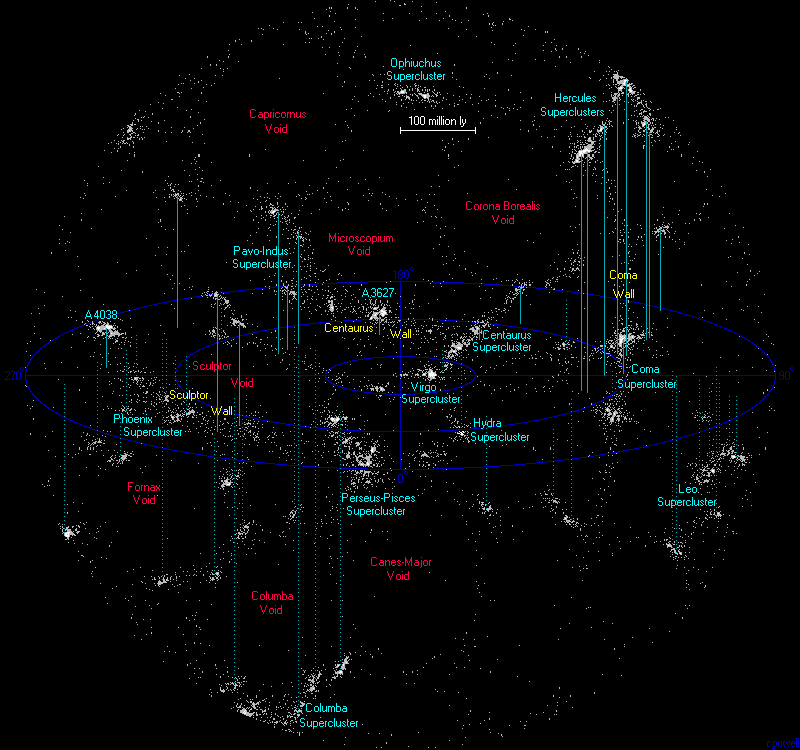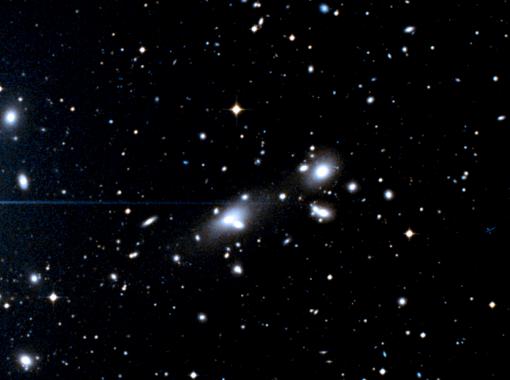
This is a map of the universe within 500 million light years. It shows most of the major galaxy superclusters that surround the Virgo supercluster. These superclusters are not isolated in space but together with many other smaller concentrations of galaxies they form parts of extensive walls of galaxies surrounding large voids. Three of the biggest walls near us are marked on the map as well as several of the largest voids. There are several hundred thousand large galaxies within 500 million light years, so even on this scale our galaxy is a very insignificant object. There is a negative version of this map, which might be easier to print.

This is a list of the nearest rich clusters of galaxies listed in the Abell catalogue. These are clusters of galaxies which contain many tens or hundreds of large galaxies. I also added the Virgo cluster to this list - George Abell excluded it from his catalogue because it covered too large an area of the sky to appear on a single photographic plate.
The Nearest Abell Clusters
~~~~~~~~~~~~~~~~~~~~~~~~~~~~
1 2 3 4 5 6 7 8 9
Abell Equatorial Supergalactic R Redshift Distance Supercluster
Number Coordinates Coordinates Mly Membership
RA Dec L° B° (H=70)
Virgo 12 29.6 +11 49 103.3 -2.8 1 .0037 52 Virgo
A3526 12 48.9 -41 18 156.4 -11.4 0 .0102 142 Centaurus
A3565 13 36.7 -33 58 151.8 -0.4 1 .0111 154 Centaurus
A1060 10 36.9 -27 32 139.4 -37.5 1 .0114 158 Hydra
A3627 16 15.5 -60 54 188.1 +7.1 1 .0145 201
A3574 13 49.2 -30 18 149.2 +3.3 0 .0148 205 Centaurus
A262 01 52.8 +36 09 335.0 -2.0 0 .0151 209 Perseus-Pisces
A3742 21 06.7 -47 09 229.7 +20.5 0 .0152 211 Pavo-Indus
A426 03 18.6 +41 31 347.7 -14.1 2 .0167 231 Perseus-Pisces
A194 01 25.6 -01 30 297.1 -7.8 0 .0168 233
A347 02 25.8 +41 52 342.8 -5.5 0 .0172 238 Perseus-Pisces
A3656 20 00.5 -38 32 221.8 +33.6 0 .0178 246 Pavo-Indus
A3698 20 36.0 -25 17 237.8 +42.2 1 .0188 260 Pavo-Indus
A569 07 09.2 +48 37 29.1 -25.6 0 .0189 262
A1367 11 44.5 +19 50 92.2 -10.5 2 .0208 288 Coma
A779 09 19.8 +33 46 60.9 -29.7 0 .0217 300
A3581 14 07.5 -27 01 147.6 +8.3 0 .0218 301 Centaurus
A1656 12 59.8 +27 59 89.6 +8.2 2 .0219 303 Coma
A2870 01 07.7 -46 55 251.0 -13.5 0 .0225 311 Phoenix
A400 02 57.6 +06 02 312.0 -27.4 1 .0232 320
A2877 01 09.8 -45 54 252.1 -13.8 0 .0235 324 Phoenix
A634 08 14.6 +58 03 37.2 -14.4 0 .0253 349
A3389 06 21.8 -64 58 211.0 -40.4 0 .0255 352
A2666 23 50.9 +27 09 320.0 +21.1 0 .0260 358
A2806 00 40.2 -56 10 240.9 -11.0 0 .0265 365 Phoenix
A539 05 16.6 +06 27 336.9 -57.1 1 .0272 375
A2199 16 28.6 +39 31 72.4 +50.2 2 .0287 395 Hercules(a)
A2836 00 53.7 -47 37 249.9 -11.3 0 .0288 397 Phoenix
A4038 23 47.7 -28 08 264.7 +6.8 2 .0288 397
A2197 16 28.2 +40 54 70.5 +49.5 1 .0296 407 Hercules(a)
A3747 21 08.7 -43 30 232.3 +23.4 0 .0298 410
A2634 23 38.3 +27 02 319.5 +23.9 1 .0298 410
A2731 00 10.2 -56 59 239.1 -7.2 0 .0300 413 Phoenix
A1177 11 09.5 +21 42 87.1 -17.3 0 .0304 418 Leo
A2896 01 18.3 -37 06 261.3 -14.0 0 .0306 421 Phoenix
A3537 13 01.0 -32 26 148.2 -7.1 0 .0308 424
A1016 10 27.0 +10 59 92.8 -31.1 0 .0310 426 Leo
A2162 16 12.5 +29 32 88.9 +50.3 0 .0310 426 Hercules(a)
A999 10 23.4 +12 51 90.4 -31.1 0 .0311 428 Leo
A1185 11 10.8 +28 41 80.8 -13.9 1 .0313 430 Leo
A397 02 57.0 +15 57 322.0 -23.3 0 .0315 433
A189 01 23.7 +01 39 300.0 -6.5 1 .0316 434
A496 04 33.6 -13 15 295.9 -55.7 1 .0317 436
A1267 11 27.9 +26 51 84.1 -11.3 0 .0317 436 Leo
A3390 06 25.0 -37 21 222.1 -67.4 1 .0321 441 Columba
A1314 11 34.8 +49 02 64.5 -0.7 0 .0323 444
A1257 11 26.1 +35 19 76.2 -8.1 0 .0332 456 Leo
A1142 11 00.9 +10 33 97.1 -23.7 0 .0337 463 Leo
A2052 15 16.8 +07 00 119.2 +36.0 0 .0338 464 Hercules(b)
A2147 16 02.3 +15 54 110.0 +48.5 1 .0338 464 Hercules(b)
A1228 11 21.5 +34 20 76.7 -9.3 1 .0340 467 Leo
A2063 15 23.0 +08 38 117.7 +37.8 1 .0341 468 Hercules(b)
A3193 03 58.2 -52 20 240.0 -39.5 0 .0345 474
A3381 06 09.9 -33 36 234.0 -69.4 1 .0347 476 Columba
A260 01 51.9 +33 10 332.1 -2.9 1 .0351 482
A1836 14 01.7 -11 36 132.5 +12.5 0 .0351 482
A2151 16 05.2 +17 45 107.3 +49.4 2 .0354 486 Hercules(b)
A3570 13 46.8 -37 55 156.2 +0.2 0 .0354 486 Shapley
A3664 20 14.0 -80 39 209.6 -6.9 1 .0357 490
A2995 02 15.2 -24 50 275.9 -24.4 1 .0360 494
A3575 13 52.6 -32 53 151.9 +3.1 0 .0365 501 Shapley
|
Column 1: The Abell catalogue number of the cluster.
Column 2: The Right Ascension in hours and minutes for epoch 2000.
Column 3: The declination in degrees and minutes for epoch 2000.
Column 4: The supergalactic longitude.
Column 5: The supergalactic latitude.
Column 6: The 'richness class' of the cluster. Roughly, this is the number of the
very brightest galaxies in the cluster:
0 = 30-49 galaxies, 1 = 50-79 galaxies, 2 = 80-129 galaxies.
Column 7: The redshift of the cluster relative to the cosmic microwave background.
Column 8: The distance to the cluster in millions of light years assuming that
the Hubble constant is 70 km/s/Mpc.
Column 9: The supercluster the cluster belongs to.
References:
Abell G, Corwin H, Olowin R, (1989), A catalogue of Rich Clusters of
Galaxies, Astrophys J Supp, 70, 1.
Struble M, Rood H, (1999), A compilation of redshifts and velocity
dispersions for ACO clusters, Astrophys J, 125, 35.


The best introduction to the subject of superclusters is this book 'Large-Scale Structures in the Universe' by Anthony Fairall, (Wiley, 1998). It is an introductory textbook which explains both the history and the future of the entire subject and also contains many accurate (two-dimensional) maps of the distribution of galaxies in the nearby universe. Some examples of his galaxy plots can be seen in this paper written by him and five colleagues in 1990.
One useful aspect of Anthony Fairall's book is that he lists many of the major voids in the local universe. This is a list of voids adapted from his list. Some of these voids are labelled on the above map and most of the nearer voids are marked on the 200 million light years map.
1 2 3 4 5 6 7 8
Void Name Equatorial Supergal. Redshift Dist. Diam.
Coordinates Coordinates z Mly Mly
RA Dec L° B°
Local Void 18.0 -10 178 +61 0.0050 70 140
Delphinus 20.0 +20 314 +74 0.0083 115 140
Eridanus 1.0 0 297 -1 0.0083 115 185
Corvus 12.0 -15 128 -17 0.0100 140 115
Gemini 6.0 +40 14 -33 0.0100 140 115
Virgo 13.5 +10 109 +11 0.0100 140 115
Cygnus 20.5 +25 323 +66 0.0117 165 115
Leo 10.5 +30 75 -21 0.0117 165 140
Taurus 3.5 +20 330 -28 0.0133 185 185
Aquila 22.0 0 282 +42 0.0150 210 140
Microscopium 18.0 -20 185 +52 0.0150 210 160
Canis Major 6.5 -20 260 -83 0.0167 235 230
Coma Berenices 13.5 +15 104 +12 0.0167 235 140
Hydra 12.0 -30 143 -19 0.0167 235 140
Corona Borealis 17.0 +35 74 +58 0.0173 240 185
Pegasus 22.0 +15 302 +45 0.0183 255 140
Sculptor 0.5 -35 261 -4 0.0183 255 275
Ursa Minor 19.0 +85 26 +21 0.0183 255 230
Ursa Major 9.0 +50 47 -19 0.0200 280 140
Columba 4.0 -30 269 -48 0.0217 305 230
Pisces 1.0 +15 311 +3 0.0233 325 140
Apus 20.0 -75 211 -1 0.0250 350 230
Fornax 2.0 -25 275 -21 0.0267 375 230
Capricornus 19.0 -35 208 +39 0.0284 395 230
|
Column 1: A name for the void.
Column 2: The Right Ascension in hours for epoch 2000.
Column 3: The declination in degrees for epoch 2000.
Column 4: The supergalactic longitude.
Column 5: The supergalactic latitude.
Column 6: The approximate redshift of the centre of the void.
Column 7: The distance to the centre of the void in millions of light years
assuming that the Hubble constant is 70 km/s/Mpc.
Column 8: The approximate diameter of the void in millions of light years.